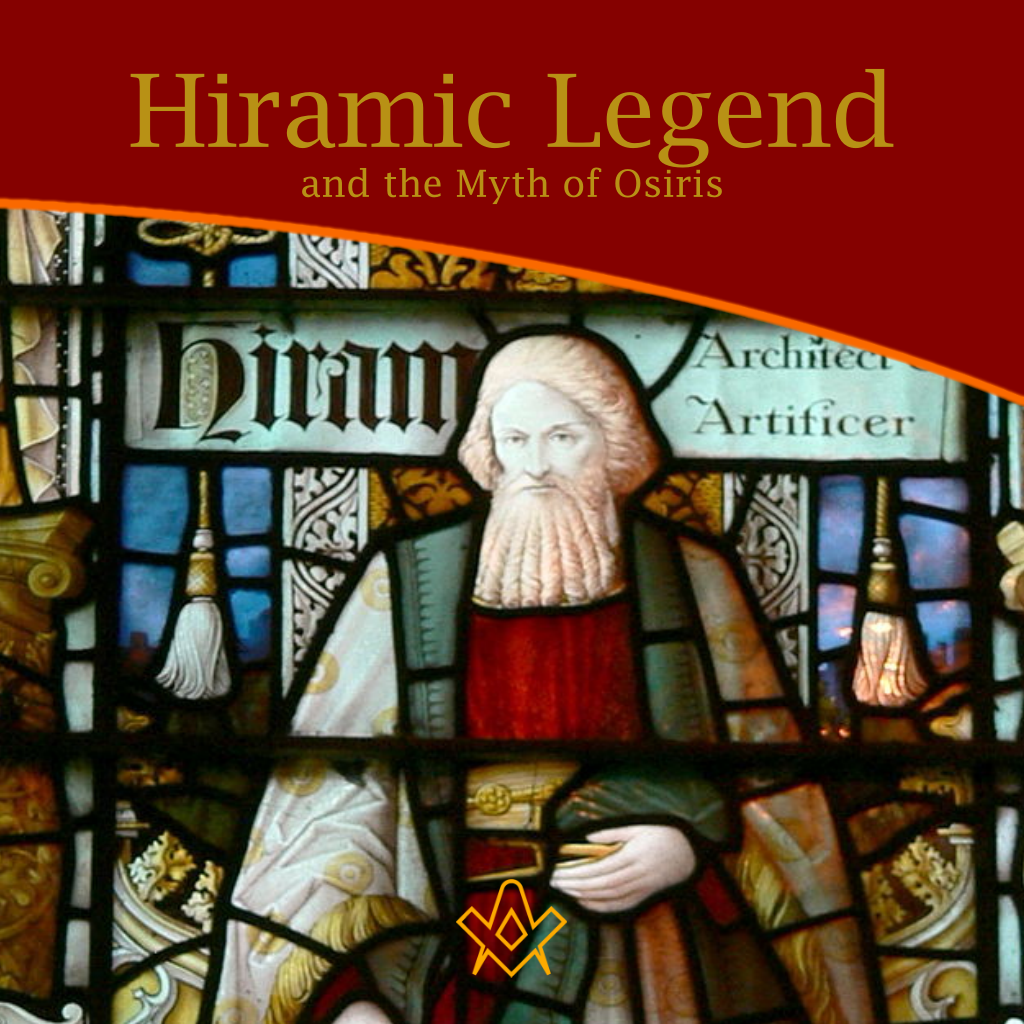Hiram Abiff, the chief architect of Solomon’s Temple, is a figure of great importance to Craft Freemasonry, as its legend serves as the foundation of the Third Degree or that of a Master Mason.
He is the central figure of an allegory that has the role of teaching the Initiate valuable alchemical lessons. Although his legend is anchored in biblical times, it may have much older roots.
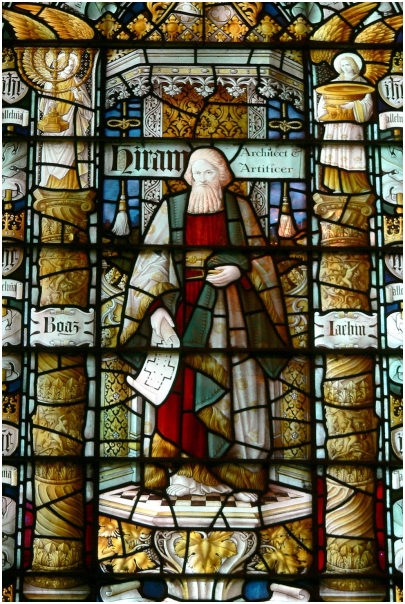
Architect Hiram, St. John’s Church, Chester (1900).
IMAGE LINKED: wikimedia Attribution 4.0 International (CC BY 4.0)
First of all, it is important to point out that the Hiramic Legend was introduced as a part of the Third Degree of Freemasonry at the beginning of the 18th century, during the development of the Fraternity’s modern system.
The origins of the legend are uncertain and there have been various theories that claim that it was part of older traditions of the Craft, before the appearance of the Grand Lodges or that it was borrowed from other secret societies, such as the Rosicrucians, for which HIRAM was supposedly an abbreviation for “Homo Jesus Redemptor Animarum” [the man Jesus redeemer of souls] or “Homo Jesus Rex Altissimus Mundi” [the man Jesus highest King of the world]. [1]
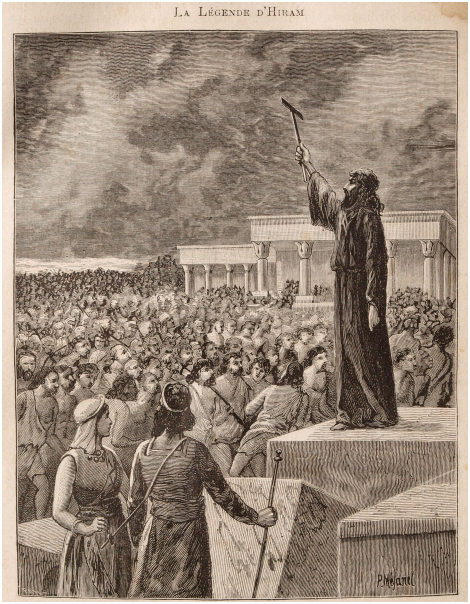
‘The Legend of Hiram’. Le Diable au XIXe siècle, Taxil. Public Domain Art
IMAGE LINKED: wikimedia Attribution 4.0 International (CC BY 4.0)
From the multitude of speculations regarding its origins, in the following paragraphs we will focus on the Myth of Osiris, which contains similarities to the Legend of Hiram Abiff, but not before briefly recalling the story of the latter:
Hiram Abiff, who was skilled in all the arts and especially in architecture, had been sent to Solomon by Hiram King of Tyre to lead a noble and vast work – the building of the Temple. Hiram Abiff had divided the workers into three categories: the Apprentices, who had the task of extracting the stones from the quarries and carving them; the Fellowcrafts, who were employed to finish the stones carved by the apprentices and set them in place under the guidance of the third class, the Masters. The latter received orders directly from Hiram.
Each category of workers had their secrets which were communicated in order to receive their due salary. Apprentices passed into the category of Fellowcrafts, and Fellowcrafts into that of Masters if the toil, intelligence and effort put into their work justified this reward.
Hiram had wisely directed the works to near the end, when the Temple was to be finished and dedicated to its purpose, but ignorance, envy and lies had sown in the souls of some of the workers the desire to obtain salary increases without work, study and self-improvement.
Three Fellowcrafts decided to forcefully snatch the secrets, without respecting the rules of the guild.
Met by Hiram’s refusal, they murdered him. In despair that they had committed so useless and difficult a crime at midnight, they carried the body to a mountain, where they dug a hole and buried Hiram.
To recognize the burial place, they planted a sprig of Acacia and fled wandering among the hills.
Hiram, not having made his appearance, King Solomon ordered to have him searched for. The body was found and King Solomon gave the order for the body to be raised using the grips of the Apprentice and then the Fellowcraft.
The efforts were unsuccessful. King Solomon feared that with the death of Hiram Abiff the word of a Master Mason would be lost.
Therefore, the first word spoken after Hiram is raised from the grave will be the substitute until the lost word can be recovered.
Hiram Abiff’s death only reaches an initiatory limit. In the Ceremony of the Third Degree, Hiram is represented as having been murdered by three assassins or, on an esoteric level, the alchemical stages of Nigredo, Albedo, and Citrinatas.
He is to be raised from the grave, for him to reintegrate into the spirit of the newly raised Master Mason and to finish the Great Work begun through him, as the fourth alchemical stage, that of Rubedo.
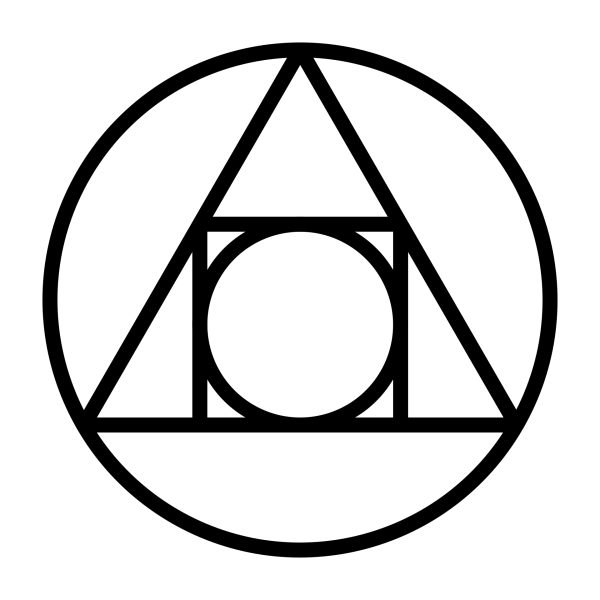
The Squared Circle: an Alchemical Symbol illustrating the interplay of the four elements of matter symbolizing the philosopher’s stone; the result of the “Great Work”.
IMAGE LINKED: wikimedia Attribution 4.0 International (CC BY 4.0)
The Myth of Osiris
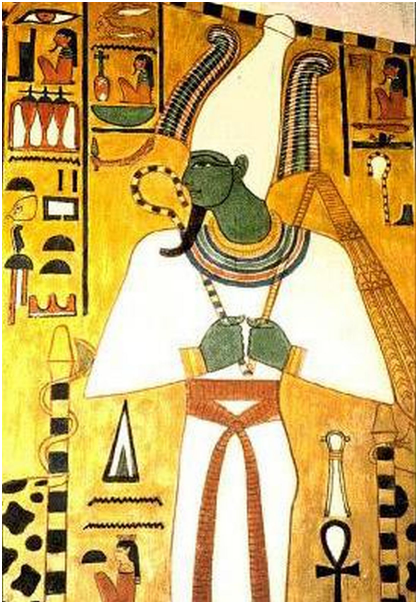
Osiris, depicted in QV66 Tomb of Nefertari.
IMAGE LINKED: wikimedia Attribution 4.0 International (CC BY 4.0)
Moving on to the Ancient Egyptians, we will detach ourselves a little from Hiram Abiff and get to know Osiris, the husband of Isis, the slain and resurrected god.
A number of 72 conjurers, led by the god Seth, conspired to kill Osiris, obtained the exact dimensions of his body and fashioned an imposing chest.
Seth threw a big party in his brother’s honor, wanting to give the chest to the one who fit it perfectly.
The conjurers tried the chest one by one. It didn’t suit anyone. For some it was too wide, for others it was too tight. It was Osiris’s turn to try it. Noticing that it fits perfectly, Osiris concludes that it will be his forever.
Then the conjurers closed the chest, nailed it, sealed it with molten lead, and threw it into the Nile.
Isis, horrified by the news, tried to find Osiris’ body. Finally, he found himself trapped in a tamarisk tree (or Acacia in other versions of the story) at Byblos in Phoenicia. The king of Byblos opened the tree, Osiris was released and Isis returned him to Egypt.
Enraged, Seth dismembered Osiris’ body and scattered it into 14 pieces in Egypt. Isis, aided by Nephthys and protected by seven scorpions, visited the whole country, and every time she found a piece she built a shrine for the Cult of Osiris.
The fourteenth part of Osiris, his phallus, has never been found. Finally, Isis fashioned a phallus out of gold and attached it to the body.
She resurrected Osiris sexually. In this way she was impregnated and conceived Horus. Horus grew up to avenge his father’s death by eventually killing Seth, and Osiris lived in the Underworld as King and Lord of the Dead.
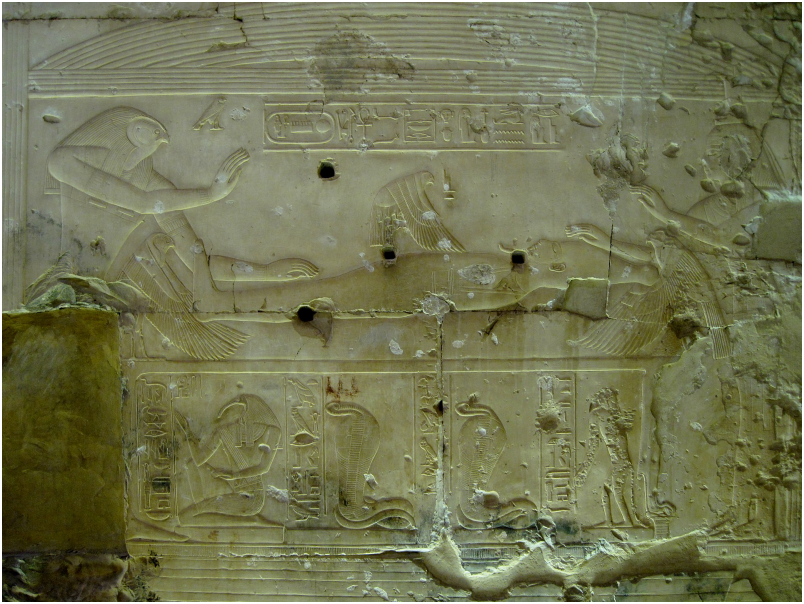
Isis, in the form of a bird, copulates with the deceased Osiris. At either side are Horus, although he is as yet unborn, and Isis in human form – Abydos Seti Temple.
IMAGE LINKED: wikimedia Attribution 4.0 International (CC BY 4.0)
Everything is mythical in both stories. Osiris could be the astronomical allegory for the dead and resurrected Sun.
Hiram Abiff, to which Freemasons look upon as the Father, and to honour his memory, are called “his widow’s children” or “the widow’s sons” – which could be a reference to Isis, the widow of the slain god, or the Moon.
The body of Hiram remained fourteen days in the grave prepared by the assassins before it was discovered in the fifteenth day (according to some versions of the legend) and Osiris’ body was split into fourteen pieces.
Thus the symbolism of both can also represent the concept of the Midnight Sun or the Moon fertilized by the Sun, the union of opposites and the birth of a third renewing and regenerating force through this sacred union.
In the figure of Osiris, the action of the Sun upon the Earth can be perceived. [2]
Osiris has the mission of reflecting the light of the Sun from the Moon to the Earth. When the Moon is in the sky like a narrow sickle, we have the first form, when it waxes we have the second form, and so on, in the course of fourteen days we have fourteen forms until the full Moon. [3]
Osiris directs towards the Earth during the fourteenth day the fourteen forms of his illuminated surface. These fourteen forms the Moon adopts to direct the light of the Sun towards us. Legend has it that Osiris was divided into fourteen limbs and buried in fourteen tombs. The fourteen forms of the Moon are the fourteen fragments of the embalmed Osiris. Full Osiris is the face of the Full Moon. [4]
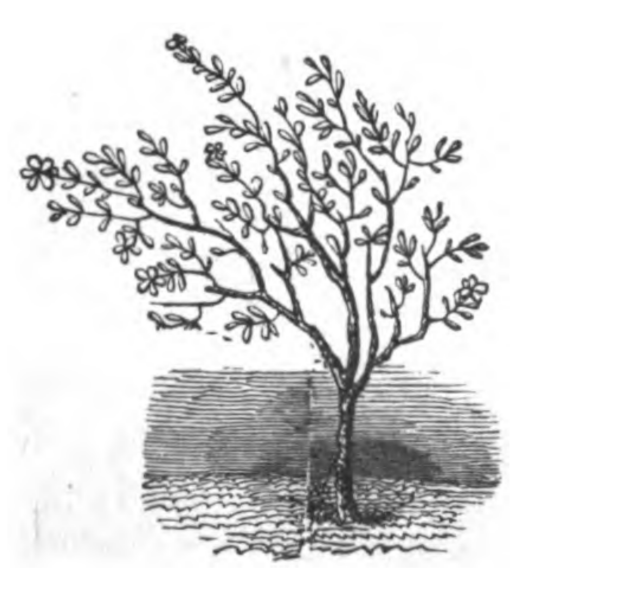
Acacia Tree – Mackey’s ‘Manual of the Lodge’, 1891.
IMAGE LINKED: wikimedia Attribution 4.0 International (CC BY 4.0)
Acacia served as a sign to find the body of both Osiris and Hiram. Through its eternal green, Acacia is taken as a symbol of immortality and evokes the Sun in its decline and growth. It is to modern Freemasons what the “lotus” was to the Egyptians.
Furthermore if we compare both legends, Osiris’ phallus was lost, just as the word of a Master Mason.
The lost word is a reference to the ineffable name of the Divinity – יהוה – in the Jewish thought, for which this Egyptian myth can bring more insight. Jewish Kabbalah mentions the loss of the true pronunciation of the Name of God – Yod-He-Vav-He .
It is not the literal pronunciation that may constitute a mystery, but the understanding of the Name.
The letter Yod represents the phallus, the male part (Adam), while the following letters He, Vav, He (Eve), the female part, these two joining harmoniously in the name of Divinity.
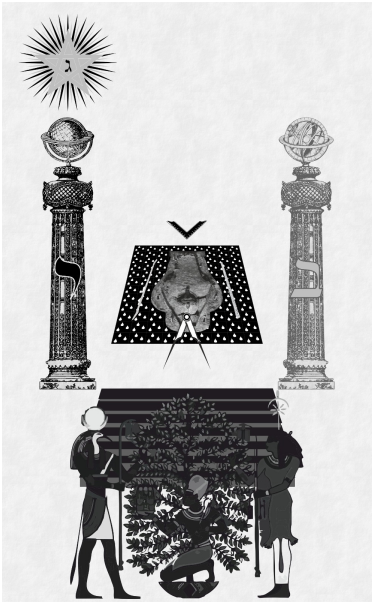
Egyptian-styled third degree tracing board
IMAGE LINKED: supplied by the author
The legends are based on a common alchemical Arcana and finding the lost word could be the endeavour of the Initiate to restructure himself on the inside, representing an internal process of transmutation rather than finding the actual pronunciation a certain string of sounds.
It can be seen as the restoration of the primordial state of androgyny of Man before the fall, the completion of the Great Alchemical Work or the unfinished Temple from the Legend of Hiram Abiff.
As with too many words the mystery vanishes, I invite the reader to continue his journey with perseverance or to start it if he hasn’t already, from Darkness to Light, in search of that which was lost.
Footnotes
References
The Story of Hiram Abiff, William Harvey
Egyptian Myths and Mysteries, Rudolf Steiner
De la maçonnerie occulte et de l’initiation hermétique, Jean-Marie Ragon
NOTES
[1] William Harvey, The Story of Hiram Abiff
[2] Egyptian Myths and Mysteries, Rudolf Steiner
[3] Ibid.
[4] Ibid.
Article by: Gabriel Anghelescu

Gabriel Anghelescu is a Romanian Freemason interested in the spiritual and esoteric aspects of the Fraternity.
His passion for esotericism and Freemasonry began at an early age. His first contact with initiatory societies was the International Order of DeMolay, a para-Masonic organization for boys aged 12 to 21. He was initiated in Jacques de Molay Chapter, in Bucharest, where he later served a mandate as the Master Councillor of his Chapter.
He received the Masonic initiation in a French Rite Lodge bearing the distinctive name of Apolodor din Damasc (Apollodorus of Damascus), working under the Grand Orient of Romania and years later he joined L'Athénée des Etrangers Lodge, which works under the auspices of the United Europe Regular Grand Lodge (Marea Lojă Regulară Europa Unită), in the Orient of Bucharest.
He is now the Grand Spokesman of the United Europe Regular Grand Lodge (Romania), a Past Master of L'Athénée des Etrangers Lodge and a member of the Ancient and Primitive Rite of Memphis 1815 (Romania).

The Lost Keys of Freemasonry: The Legend of Hiram Abiff
By: Manly P. Hall
2013 Reprint of 1946 Fifth Edition. Full facsimile of the original edition, not reproduced with Optical Recognition Software. Mr. Hall, himself an honorary 33x Mason, reveals the profounder aspects of this ancient Fraternity which has been a source of inspiration to so many individuals through the centuries.
The basic symbolism of the three degrees of the Blue Lodge is explained. The text can be read with profit by both new and old Masons, for within its pages lies an interpretation of Masonic symbolism which supplements the monitorial instruction usually given in the lodges.
The leading Masonic scholars of all times have agreed that the symbols of the Fraternity are susceptible of the most profound interpretation and thus reveal to the truly initiated certain secrets concerning the spiritual realities of life. Freemasonry is therefore more than a mere social organization a few centuries old, and can be regarded as a perpetuation of the philosophical mysteries and initiations of the ancients.
This is in keeping with the inner tradition of the Craft, a heritage from pre-Revival days. The present volume will appeal to the thoughtful Mason as an inspiring work, for it satisfies the yearning for further light and leads the initiate to that Sanctum Sanctorum where the mysteries are revealed.
The book is a contribution to Masonic idealism, revealing the profounder aspects of our ancient and gentle Fraternity – those unique and distinctive features which have proved a constant inspiration through the centuries. Chapters Include: Chapter I – The Eternal Quest Chapter II – The Candidate Chapter III – The Entered Apprentice Chapter IV – The Fellow Craft Chapter V – The Master Mason Chapter VI – The Qualifications of a True Mason Epilogue

Egyptian Myths and Mysteries
By: Rudolf Steiner
“Egyptian Myths and Mysteries” is a book made up of a series of lectures which Rudolf Steiner gave at Leipzig in September 1908.
“Egyptian Myths and Mysteries” contains 12 lectures in all, covering things like the stages of evolution, the mysteries of the planets, Atlantis, old initiation centres and spiritual connections between ancient and modern times. He links all this to ancient Egyptian practices and beliefs with the penultimate lecture being the Egyptian doctrine of evolution.
Steiner reveals here the deep spiritual connection of our modern epoch with Egypt and why it is important to study its civilization with its profound wisdom, its extraordinary knowledge of cosmic laws, and its myths, which are meaningful for us now. Steiner emphasizes the astonishing and special relationship between our own time and that of ancient Egypt–how, in the natural rhythm of the ages, the so-called third post-Atlantian (Egyptian) epoch is mirrored by the fifth (present) epoch. In this sense, today it is especially relevant to look at ancient Egypt with fresh eyes.
He goes into the experiences of the Egyptian initiations, facts of occult anatomy and physiology, the stages of evolution of the human form, and more, culminating with a lecture on Christ as the conqueror of matter.

De la maçonnerie occulte et de l’initiation hermétique
By: Jean-Marie Ragon
[Translated from French]
Edition of 1853 The occult sciences reveal to man the mysteries of his nature, the secrets of his organization, the means of achieving his perfection and happiness.
Their study was that of the high Egyptian initiations. The first goal was to pull man out of the state of barbarism to civilize him, and to take civilized man to perfect him, in order to bring back the man who was believed to have fallen to his first nature.
The second aim was the search for the means of restoring matter to its first nature, from which it was also believed to have fallen. Thus, mystagogy or initiation into the mysteries had its two divisions. In the first, only inclinations were purified, only men were passed to the crucible; it was an alchemy of spirits, a human mystagogy. The second was the initiation into the mysteries of the operations of nature, a mystagogy of bodies.
In one, we sought the cubic stone or the cornerstone of the temple of philosophy, capable of uniting intellectually by this ingenious symbol, all humanity in the same faith, the same hope, the same love. In the other, we were looking for what can bring back the golden age: the philosopher’s stone and the elixir that prolongs life…
Recent Articles: symbolism
 The Practice of Freemasonry - P1 Embark on a transformative journey with Freemasonry, where the exploration of your Center unlocks the Perfect Ashlar within. Through the practices of Brotherly Love, Relief, Truth, and Cardinal Virtues, discover a path of enlightenment and self-improvement. Embrace the universal creed that binds us in the pursuit of our true essence. |
 Discover the fascinating history and significance of the Warrant of Constitution within Freemasonry. Unveil the evolution of this crucial authorization, its role in legitimizing Lodges, and its lasting impact on the global brotherhood of Freemasons. Explore the intricate link it provides between tradition and modern practice. |
 Freemasonry: Unravelling the Complexity of an Influential Organization Mysterious and captivating, Freemasonry has piqued the interest of seekers and skeptics alike. With its intricate blend of politics, esotericism, science, and religion, this enigmatic organization has left an indelible mark on society. Prepare to delve into the secrets of Freemasonry and unlock its hidden depths. |
 Unlocking the Mysteries of Freemasonry: In the hallowed halls of Freemasonry, a powerful symbol lies at the heart of ancient rituals and teachings—the Volume of the Sacred Law. This sacred book not only guides the spiritual and moral journey of Freemasons but also serves as a beacon of universal wisdom and enlightenment. |
 The Ancient Liberal Arts in Freemasonry Embark on a journey of self-improvement and wisdom with Freemasonry's guiding principles. Ascend the winding stairs of moral cultivation, analytical reasoning, and philosophical understanding. Embrace arithmetic's mystical properties and geometry's universal truths. Let the harmony of the universe inspire unity and growth. Discover the profound, hidden knowledge in Freemasonry's path to enlightenment. |
 Initiation rituals around the world are filled with fascinating elements and different images. One of them is that of darkness. When societies speak of darkness, they often mean a lack of knowledge, a lack of choice, or a symbol of evil. During initiation rituals, darkness is used to represent the initiate's lack of knowledge about the world, society, and initiation in general. It can also represent the initiate's inability to make a choice or endure a situation. Whether you have participated in an initiation rite or not, the meaning of darkness remains an intriguing concept worth exploring. Initiation rituals around the world are filled with fascinating elements and different images. One of them is that of darkness. When societies speak of darkness, they often mean a lack of knowledge, a lack of choice, or a symbol of evil. During initiation rituals, darkness is used to represent the initiate's lack of knowledge about the world, society, and initiation in general. It can also represent the initiate's inability to make a choice or endure a situation. Whether you have participated in an initiation rite or not, the meaning of darkness remains an intriguing concept worth exploring. |
 Masonic Deacon rods potentially trace their origins to Greek antiquity, symbolically linked to Hermes' caduceus. As Hermes bridged gods and mortals with messages, so do Masonic Deacons within the lodge, reinforcing their roles through ancient emblems. This connection underscores a profound narrative, weaving the fabric of Masonic rites with the threads of mythological heritage, suggesting the rods are not mere tools but bearers of deeper, sacred meanings that resonate with the guardianship and communicative essence of their divine counterpart, Hermes, reflecting a timeless lineage from myth to Masonic tradition. |
 The biblical pillars erected by Solomon at the Temple's porch, hold a profound place in history. These brass behemoths are not mere decorations; they are symbols of strength, establishment, and divine guidance. Explore their fascinating construction, dimensions, and the deep meanings they carry in both biblical and Masonic contexts. |
 Unlocking the Mind's Potential: Dive deep into ground breaking research revealing how simple daily habits can supercharge cognitive abilities. Discover the untapped power within and redefine your limits. Join us on this enlightening journey and transform your world! |
 Dive deep into the symbolic importance of the trowel in Masonry, representing unity and brotherly love. From its historical roots in operative masonry to its significance in speculative masonry, this article explores the trowel's multifaceted role. Discover its connection to the sword, the story of Nehemiah, and the Society of the Trowel in Renaissance Florence. Unravel the layers of meaning behind this enduring Masonic symbol. |
 Symbolism of The Builder's Jewel Batty Langley's "The Builder’s Jewel" (1741) is a visual masterpiece of Masonic symbolism, showcasing Langley's deep understanding of Freemasonry. The frontispiece highlights key symbols like the three pillars and the legend of Hiram Abiff, emphasizing Langley's dedication to Masonic traditions and teachings. |
 Unveil the mystique of the colour blue in Masonic symbolism. A hue evoking universal friendship and benevolence, its roots span ancient cultures, infusing Freemasonry's core values. This article explores blue's profound significance, guiding Freemasons towards wisdom and spiritual enlightenment. Discover the fascinating journey of this universal symbol. |
 Discover the intriguing world of the plumb in Masonic symbolism with our in-depth analysis. Uncover its rich history, moral teachings, and significance in Freemasonry, guiding members on their path to truth, integrity, and justice. Immerse yourself in the captivating power of this symbol that shapes lives within the brotherhood. |
 Unlock the mysteries of Freemasonry with 'The Key,' a profound Masonic symbol. This seemingly simple instrument holds a deeper meaning, teaching virtues of silence and integrity. Explore its ancient roots, from Sophocles to the mysteries of Isis, and discover how it symbolizes the opening of the heart for judgment. |
 Unlock the secrets of the Freemasonry with The Blazing Star - a symbol that holds immense significance in their rituals and practices. Delve into its history, meaning and role in the different degrees of Freemasonry with expert insights from the Encyclopedia of Freemasonry by Albert Mackey. Discover the mystique of The Blazing Star today! |
 There is no symbol more significant in its meaning, more versatile in its application, or more pervasive throughout the entire Freemasonry system than the triangle. Therefore, an examination of it cannot fail to be interesting to a Masonic student. Extract from Encyclopedia of Freemasonry by Albert Mackey |
 The Hiramic Legend and the Myth of Osiris Hiram Abiff, the chief architect of Solomon’s Temple, is a figure of great importance to Craft Freemasonry, as its legend serves as the foundation of the Third Degree or that of a Master Mason. He is the central figure of an allegory that has the role of teaching the Initiate valuable alchemical lessons. Although his legend is anchored in biblical times, it may have much older roots. |
 This rite of investiture, or the placing upon the aspirant some garment, as an indication of his appropriate preparation for the ceremonies in which he was about to engage, prevailed in all the ancient initiations. Extract from The Symbolism of Freemasonry by Albert G. Mackey |
 The All-Seeing Eye of God, also known as the Eye of Providence, is a representation of the divine providence in which the eye of God watches over humanity. It frequently portrays an eye that is enclosed in a triangle and surrounded by rays of light or splendour. |
 What's in a Word, Sign or Token? Why do Freemasons use passwords, signs, and tokens? As Freemasons we know and understand the passwords, signs and tokens (including grips), which are all used a mode of recognition between members of the fraternity. |
 A Temple of Living Stones: Examining the Concept of a Chain of Union What are the origins of the Chain of Union? And how did they come about ? The answers may surprise some members as W Brother Andrew Hammer investigates, author of Observing the Craft: The Pursuit of Excellence in Masonic Labour and Observance. |
 One of the best loved stories for the festive season is ‘A Christmas Carol’. A traditional ghost story for retelling around the fire on a cold Christmas Eve, it is a timeless classic beloved by those from all walks of life. Philippa explores the masonic allegory connections… |
 The Trowel - Working Tool of the Master Mason The Trowel is the symbol of that which has power to bind men together – the cement is brotherhood and fellowship. |
 Two Perpendicular Parallel Lines The point within a circle embordered by two perpendicular parallel lines, with the Holy Bible resting on the circle, is one of the most recognizable symbols in Freemasonry. It is also one which always raises a question. How can two lines be both perpendicular and parallel? |
 "The first great duty, not only of every lodge, but of every Mason, is to see that the landmarks of the Order shall never be impaired." — Albert Mackey (1856) |
 It is common knowledge that the ancient wages of a Fellowcraft Mason consisted of corn, wine, and oil. |
 “Do not come any closer,” God said. “Take off your sandals, for the place where you are standing is holy ground.” Exodus 3:5 |
 The Secret Language of the Stone Masons We know of Masons' Marks but lesser known are the 'argots' used by the artisans - in part 2 of a series on the social history of the Operative Masons we learn how the use of secret languages added to the mystery of the Guilds. |
 The phrase appears in the Regius Poem. It is customary in contemporary English to end prayers with a hearty “Amen,” a word meaning “So be it.” It is a Latin word derived from the Hebrew word - Short Talk Bulletin - Vol. V June, 1927, No.6 |
 Egypt's 'Place of Truth' - The First Operative Stone Masons' Guild? Was ancient Egypt's 'village of the artisans' the first operative stone masons' guild? And was their use of 'identity marks' a forerunner of the Mason's Marks of the cathedral builders of the Middle Ages? Read on for some possible answers… |
 The Pieces of Architecture and the Origin of Masonic Study Discover the journey of the Apprentice – from Operative to Speculative. This journey has been carried out since the times of operative Freemasonry but today the initiate works in the construction of his inner temple. |
 The Builders' Rites - laying the foundations operatively and speculatively The cornerstone (also ‘foundation’ or ‘setting’ stone) is the first stone to be set in the construction of the foundations of a building; every other stone is set in reference to this. |
 Applying the working tools to achieve our peculiar system of morality. |
 We take an in-depth look at the 47th Proposition of the 1st Book of Euclid as part of the jewel of the Past Master. |
 The Cable Tow: Its Origins, Symbolism, & Significance for Freemasons - Unbinding the significance of the cable tow. |
 We examine at one of the most impressive moments of the initiatory ceremony, a certain rite known as Circumambulation, and ask what is its meaning and purpose ? |
 So, what is the Level? And why do we use it in Freemasonry? |
 What is the mysterious pigpen or Masonic cipher that has been used for centuries to hide secrets and rituals? |
 The Story of the Royal Arch - The Mark Degree Extracted from William Harvey's 'The Story of the Royal Arch' - Part 1 describes the Mark Degree, including the Working Tools. |
 Ashlars - Rough, Smooth - Story of a Stone How we can apply the rough and smooth Ashlars with-in a masonic context |
 A detailed look at the Chamber of Reflection: A Revitalized and Misunderstood Masonic Practice. |
 Exploring the origin and symbolism of Faith, Hope and Charity |
 The Noachite Legend and the Craft What is it to be a true Noachidae, and what is the Noachite Legend and the Craft ? |
 In Masonic rituals, Jacob’s ladder is understood as a stairway, a passage from this world to the Heavens. |
 What is the meaning of the Acacia and where did it originate ? |
 What is the connection with the Feasts of St John and Freemasonry |
 The Forget-Me-Not and the Poppy - two symbols to remind us to 'never forget' those who died during the two World Wars. |
 Biblical history surrounding the two pillars that stood at the entrance to King Solomon's Temple |
 Is there a direct link between Judaism and Freemasonry? |
 The symbolism of the beehive in Masonry and its association with omphalos stones and the sacred feminine. |
 The Wages of an Entered Apprentice |
 An explanation of the North East corner charge which explores beyond one meaning Charity - |
 A brief look at the origins of the two headed eagle, probably the most ornamental and most ostentatious feature of the Supreme Council 33rd Degree Ancient and Accepted (Scottish ) Rite |
 A Muslim is reminded of his universal duties just as a Freemason. A Masonic Interpretation of the Quran's First Two Chapters |
 The three Latin words -{Listen, Observe, Be Silent}. A good moto for the wise freemason |
masonic knowledge
to be a better citizen of the world
share the square with two brothers

click image to open email app on mobile device


